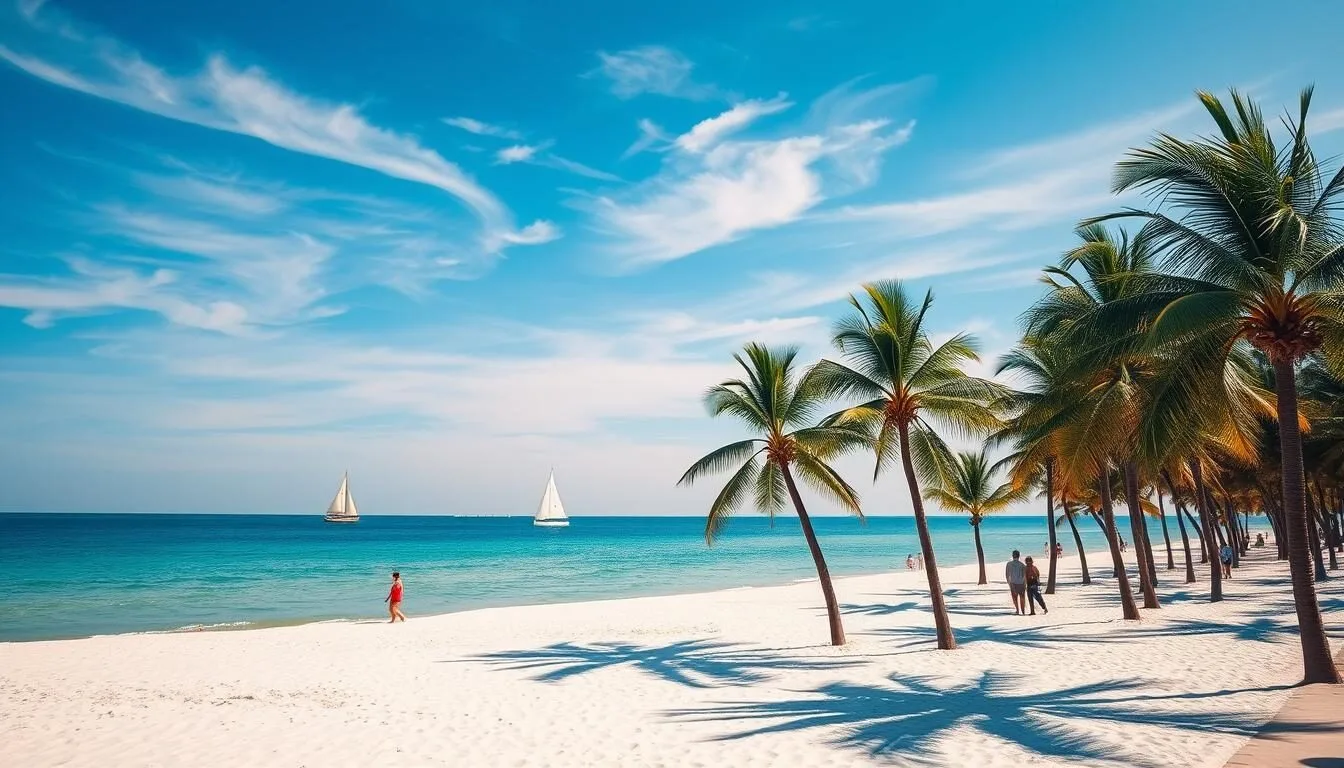✓ Accommodations✓ Flights✓ Rental Cars✓ Tours & Activities
Did you know that Pensacola’s Gulf Coast experiences a subtropical climate, making it an attractive destination for travelers seeking warm weather and beautiful beaches? With its unique blend of stunning beaches, historical sites, and vibrant cultural events, Pensacola is a gem on the Florida Gulf Coast.
Understanding the local weather patterns is crucial to making the most of your visit. The city has two primary seasons: a wet season from May to October and a dry season from November to April. By planning your trip during the optimal time, you can enjoy comfortable temperatures, minimal rainfall, and ideal conditions for outdoor activities.
Whether you’re looking to soak up the sun on Pensacola Beach or explore the city’s rich history, timing your visit correctly will enhance your overall experience in this charming Gulf Coast city.
Understanding Pensacola’s Unique Climate
Pensacola’s weather patterns are influenced by its proximity to the Gulf of Mexico. This unique geographic location contributes to the city’s subtropical climate, characterized by mild winters and hot, humid summers.
Geographic Influences on Weather Patterns
Pensacola’s coastal location on the Gulf of Mexico significantly impacts its weather. The warm waters of the Gulf contribute to the city’s high humidity levels, especially during the summer months. Additionally, the city’s position on the Florida Panhandle makes it susceptible to weather patterns from both the Gulf and the Atlantic Ocean.
Wet vs. Dry Seasons in Pensacola
Pensacola experiences a distinct wet and dry season, which greatly affects the time of year you visit. The wet season, spanning from June to September, sees the most rainfall in July and August, with an average of 16 rainy days per month. In contrast, the dry season, from October to May, offers more reliable weather for outdoor activities, with April being the driest month, averaging only 6 rainy days.
| Season | Months | Average Rainy Days | Humidity Levels |
|---|---|---|---|
| Wet Season | June to September | 16 days (July & August) | High |
| Dry Season | October to May | 6 days (April) | Lower |
Understanding these seasonal variations helps you plan your trip accordingly, ensuring a more enjoyable experience in Pensacola.
Pensacola, Florida: Best Months for a Weather-Savvy Trip
When planning a trip to Pensacola, Florida, timing is everything to ensure a weather-savvy vacation. The city’s subtropical climate means that weather conditions vary significantly throughout the year, impacting the quality of your visit.
Spring (March-May): The Sweet Spot
Spring is considered a sweet spot for visiting Pensacola, with mild temperatures and fewer crowds making it an ideal time to enjoy the city’s beach and outdoor activities. As the season progresses, the weather warms up, but it remains comfortable, with average highs in the mid-70s to low 80s Fahrenheit. This period is perfect for experiencing Pensacola’s natural beauty without the peak season crowds.
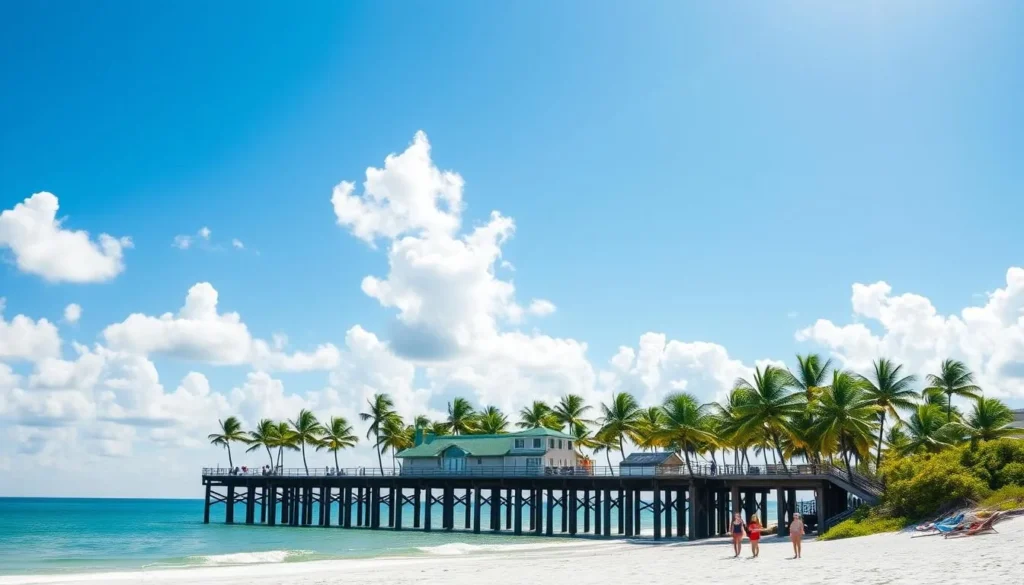
Fall (September-November): The Hidden Gem
Fall represents another excellent opportunity to visit Pensacola, offering a hidden gem of a season with warm weather and fewer crowds. The fall temperatures range from 82°F in September to 65°F in November, making it an excellent time to enjoy outdoor activities. The water remains warm enough for swimming through October, extending the beach season. By early November, the risk of hurricanes diminishes, making it a great period to visit.
| Month | Average High Temperature | Water Temperature |
|---|---|---|
| September | 82°F | 80°F |
| October | 75°F | 75°F |
| November | 65°F | 70°F |
Visiting in the fall allows you to enjoy Pensacola’s charms with the added benefit of lower accommodation rates and smaller crowds at popular attractions.
Winter in Pensacola: December to February
If you’re planning a trip to Pensacola during the winter months, you’ll discover a city that’s vibrant with cultural events and historical significance. The winter season brings a unique charm to Pensacola, with mild temperatures and a range of activities that make it an excellent time to explore the city’s rich heritage.
Temperature and Rainfall Expectations
During the winter months, Pensacola experiences mild temperatures, averaging between 50°F to 70°F (10°C to 21°C). This period is characterized by lower humidity and moderate rainfall, making it ideal for outdoor activities and sightseeing. You can expect an average rainfall of around 4-5 inches per month, with December being one of the wettest months of the winter season.
| Month | Average Temperature (°F) | Average Rainfall (inches) |
|---|---|---|
| December | 58 | 4.5 |
| January | 52 | 4.2 |
| February | 55 | 4.0 |
Winter Activities and Attractions
Winter in Pensacola opens up a different side of the city, with a focus on cultural and historical attractions rather than beach activities. You can explore the world-class National Naval Aviation Museum without the summer crowds, enjoying more personal space and time to appreciate the impressive collection of aircraft and naval history. The winter months also bring special seasonal events like the Pensacola Mardi Gras celebrations, which kick off in January and offer a family-friendly version of this Gulf Coast tradition.

Outdoor activities shift toward nature trails, bird watching, and exploring historic sites like Fort Barrancas and the historic Pensacola Village, all more comfortable in the mild winter temperatures. Winter visitors enjoy a more authentic experience of the city, interacting with locals rather than tourists and discovering why Pensacola is not just a summer beach destination but a place rich in culture and history year-round.
Spring in Pensacola: March to May
With the arrival of spring, Pensacola transforms into a beautiful destination, offering a mix of relaxation and adventure. As the weather warms up, the city comes alive with various activities and events.
Weather Conditions During Spring
During the spring months, Pensacola experiences mild temperatures, making it an ideal time to enjoy outdoor activities. The average high temperature in March is around 73°F, rising to 79°F in April and 84°F in May. Spring is also a relatively dry season, with moderate humidity levels, making it a comfortable time to visit Pensacola and enjoy the beach.
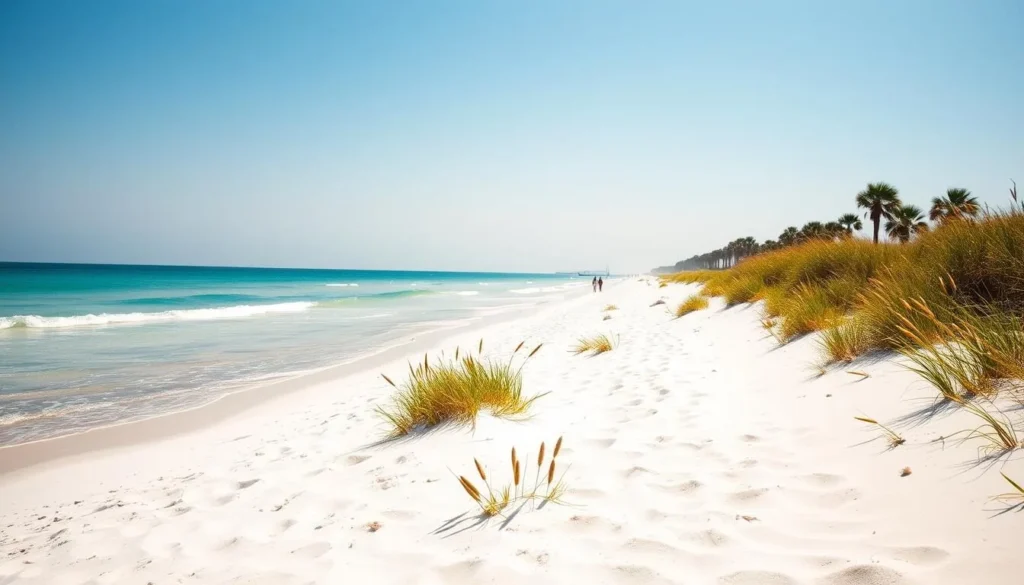
Spring Break Considerations
Spring Break is a significant event in Pensacola, particularly in March, when many colleges schedule their breaks. This period brings a younger crowd to the area, transforming the atmosphere with increased activities like volleyball tournaments and beach concerts. However, it’s also a time when crowds surge, and accommodation rates skyrocket. If you’re looking for a more relaxed experience, consider visiting in April or early May when the crowds have dissipated, and prices are more reasonable.
You should also note that different school districts have Spring Break at various times, creating waves of visitors throughout March and early April. Planning your trip around these periods can help you avoid the peak crowds and make the most of your time in this beautiful place.
Summer in Pensacola: June to August
Pensacola’s summer season, spanning June to August, is characterized by warm weather and exciting water activities. This period is ideal for those who enjoy the beach and various outdoor pursuits.
Heat, Humidity, and Afternoon Thunderstorms
Summer in Pensacola is marked by high temperatures and humidity. Afternoon thunderstorms are a common occurrence, but they typically pass quickly. To make the most of your beach days, plan your activities around these storms by visiting the beach in the early morning or late evening.
Strategic timing is key: early mornings (before 11 AM) and evenings (after 5 PM) offer the most comfortable temperatures and usually avoid the afternoon thunderstorm window.
Beach Conditions and Water Activities
Summer water temperatures in Pensacola reach their peak, averaging 82°F-85°F, creating ideal conditions for swimming, snorkeling, and other water activities. The Gulf Coast waters are generally calmer than those on the Atlantic coast, making them perfect for paddleboarding, kayaking, and other smooth-water activities.
| Activity | Best Time | Conditions |
|---|---|---|
| Swimming, Snorkeling | Early morning, Late evening | Warm water (82°F-85°F) |
| Paddleboarding, Kayaking | Early morning | Calm waters |
| Jet Skis, Parasailing | Anytime | Favorable summer conditions |
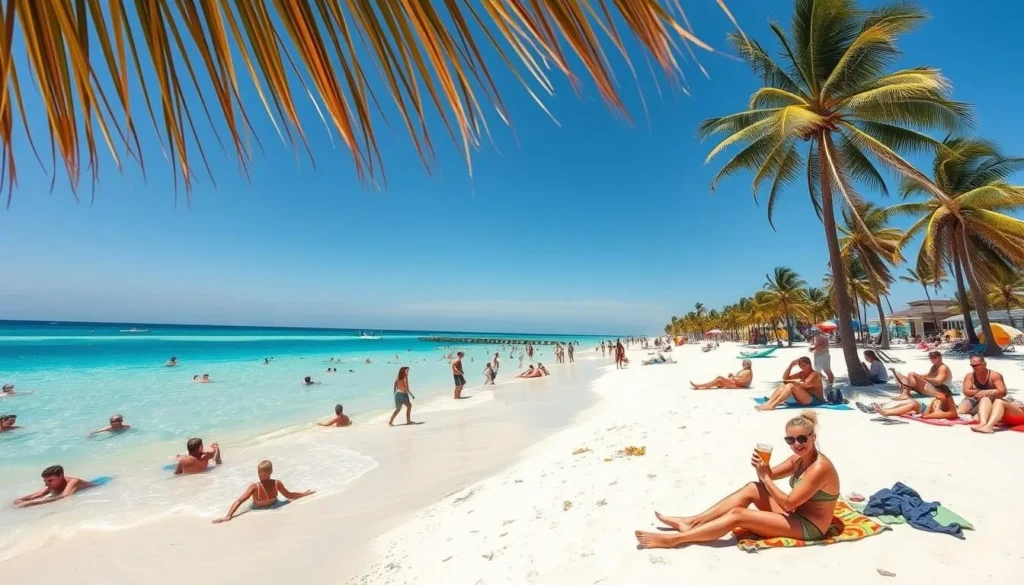
Fall in Pensacola: September to November
As summer fades, Pensacola transforms into a vibrant autumn destination, offering a unique blend of pleasant weather and exciting events. This transition makes fall an attractive time to visit Pensacola.
Transitioning Weather Patterns
During the fall season, Pensacola experiences a gradual cooling of temperatures, making it an ideal time to enjoy outdoor activities without the intense summer heat. The weather remains pleasant through October, with fewer crowds at the beaches.
| Month | Average High Temperature | Average Rainfall |
|---|---|---|
| September | 84°F | 5.5 inches |
| October | 78°F | 4.3 inches |
| November | 72°F | 4.1 inches |
Fall Events and Attractions
Fall in Pensacola is marked by several significant events and attractions. Some of the highlights include:
- The Pensacola Seafood Festival in late September, celebrating the region’s seafood with culinary delights and live music.
- The Great Gulfcoast Arts Festival in early November, featuring over 200 artists and live performances.
- The Blue Angels Homecoming Air Show in November, a spectacular display of aerobatics.
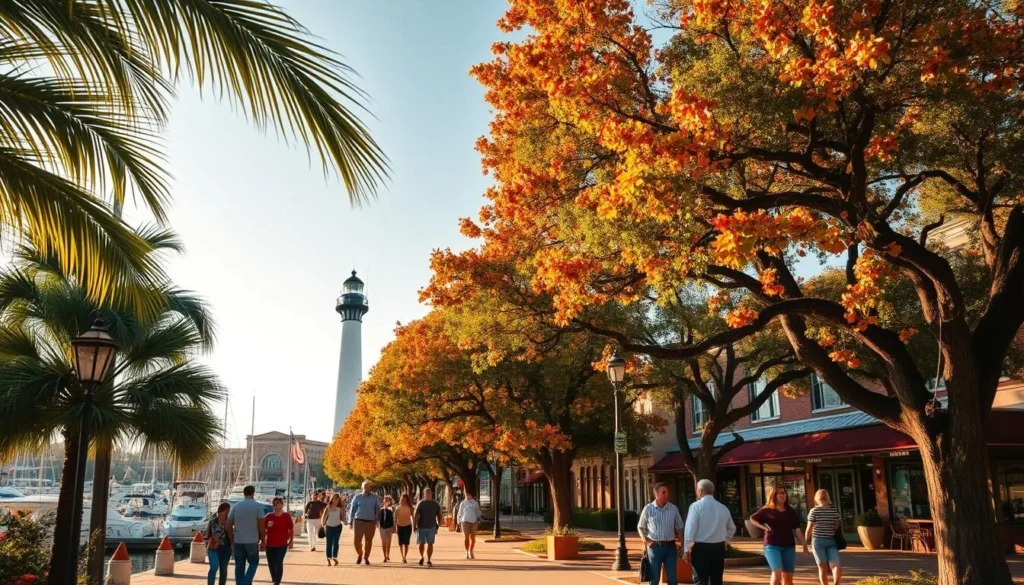
The combination of pleasant weather and significant events makes fall an excellent time to visit Pensacola and enjoy a more immersive experience at its attractions and beaches.
Hurricane Season: What Travelers Should Know
If you’re traveling to Pensacola during hurricane season, being informed is key to a smooth experience. Hurricane season, which affects the Gulf Coast, including Pensacola, Florida, can be a significant concern for travelers. Understanding the risks and being prepared can make a big difference in your trip.
Timeline and Risks
Hurricane season in Pensacola officially runs from June 1 to November 30, with the peak months being August and September. During this time, the risk of hurricanes and tropical storms is higher, potentially impacting your travel plans. It’s essential to be aware of the weather forecasts and warnings issued by reliable sources like the National Hurricane Center.

Travel Insurance and Planning
To mitigate the risks associated with hurricane season, consider purchasing travel insurance with hurricane coverage. Many hotels and vacation rentals in Pensacola offer “hurricane guarantees” or flexible rebooking policies, allowing you to adjust your plans if a named storm threatens the area. Creating a contingency plan, including knowing your airline’s weather policy and having alternative travel dates, is also crucial.
By staying informed and planning ahead, you can enjoy your trip to Pensacola even during hurricane season. Most days during this period are unaffected by tropical systems, so with the right preparation, you can have a wonderful experience.
- Purchasing travel insurance with specific hurricane coverage can provide valuable peace of mind.
- Many Pensacola accommodations offer flexible rebooking policies during hurricane season.
- Staying weather-aware through trusted sources is crucial for travelers during this time.
Pensacola Beach: Best Times to Visit

Whether you’re seeking a lively atmosphere or a peaceful retreat, Pensacola Beach has its best times to visit. The beach experience varies significantly across different times of the year.
Water Temperatures Throughout the Year
Pensacola Beach’s water temperature fluctuates throughout the year, making some seasons more suitable for swimming than others. Summer months bring warm waters, ideal for swimming and water activities. In contrast, winter months see a significant drop, making it less ideal for swimming but perfect for serene beach walks.
Beach Crowds by Season
The crowd at Pensacola Beach changes dramatically with the seasons. Summer, particularly July and August, sees the largest crowds, especially on weekends. Spring Break in March attracts a significant number of college students, while September and October offer a more relaxed experience with warm waters and fewer crowds. Visiting on weekdays instead of weekends can significantly reduce the crowd experience.
Monthly Weather Breakdown in Pensacola
Understanding the monthly weather breakdown in Pensacola is crucial for planning a trip that suits your preferences. Pensacola’s climate varies throughout the year, offering different experiences for visitors depending on when they choose to visit.
January to April Weather Patterns
The first four months of the year bring mild temperatures to Pensacola, making it an attractive time to visit for those who prefer cooler weather. January and February are the coolest months, with average temperatures ranging from 48°F to 64°F. As spring begins, March and April see a gradual warming, with temperatures between 58°F and 75°F, making it ideal for outdoor activities.
During these months, rainfall is relatively moderate, with an average of 4-5 rainy days per month. This period is perfect for enjoying Pensacola’s beaches and outdoor attractions without the peak season crowds.
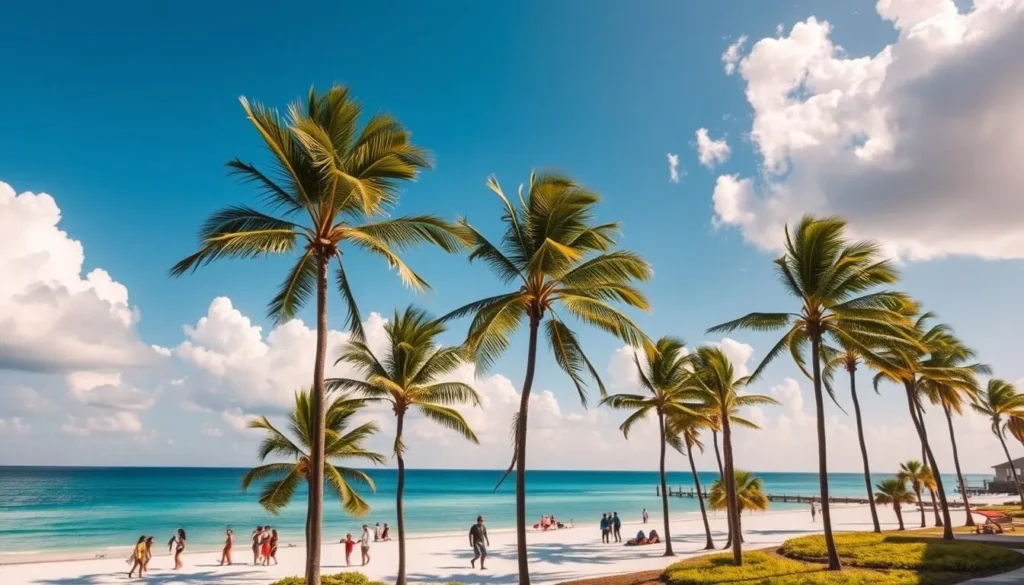
May to August Weather Patterns
Summer in Pensacola is characterized by hot temperatures and high humidity, with July and August being the peak summer months. Temperatures often reach the mid-90s, making it essential for visitors to stay hydrated and plan indoor activities during the hottest parts of the day.
Afternoon thunderstorms are common during these months, contributing to the region’s rainfall. Despite the heat, summer is a great time for water activities and enjoying the beach.
September to December Weather Patterns
As summer fades, September still retains some of the warm weather, with temperatures gradually cooling down through October and November. By December, winter begins to set in, with cooler temperatures and occasional cold fronts.
| Month | Temperature Range (°F) | Average Rainy Days |
|---|---|---|
| September | 71-86 | 14 |
| October | 62-79 | 8 |
| November | 53-71 | 7 |
| December | 48-64 | 9 |
This period offers a pleasant transition from the hot summer months to the cooler winter season, with October and November being particularly pleasant due to the mild temperatures and reduced rainfall.
Special Events and Festivals by Season
Experience the best of Pensacola through its vibrant events and festivals, tailored to every season. The city’s event calendar is packed with exciting activities that cater to different interests, ensuring that there’s something for everyone.
Winter and Spring Events
As winter transitions to spring, Pensacola comes alive with various events. You can enjoy the weekly Bands on the Beach concerts at the Pensacola Beach Gulfside Pavilion every Tuesday evening from April through October. These concerts feature local and regional musicians performing a range of genres.
Spring is also a great time to experience the city’s cultural side, with events like the Seville Quarter’s numerous festivals.
Summer and Fall Celebrations
Summer in Pensacola is highlighted by the Pensacola Beach Air Show in July, featuring the world-famous Blue Angels. The Pensacola Fishing Rodeo in June is another summer highlight, celebrating the area’s world-class fishing.
Fall brings its own set of exciting events, including the Pensacola Seafood Festival in September and the Great Gulfcoast Arts Festival in November. The Blue Angels Homecoming Air Show in November is a must-see, drawing large crowds.
Outdoor Activities: Weather-Based Planning
To make the most of your outdoor adventures in Pensacola, understanding the local weather patterns is crucial. Pensacola offers a wide range of outdoor activities that can be enjoyed throughout the year, but the comfort and safety of these activities depend heavily on the weather.
Water Sports and Beach Activities
Water sports and beach activities are popular in Pensacola, with the Gulf Islands National Seashore offering numerous opportunities for swimming, kayaking, and paddleboarding. The best time for these activities is during the warmer months when the water temperature is comfortable. However, it’s essential to be mindful of the hurricane season and plan accordingly. Summer months require extra caution due to afternoon thunderstorms. Always check the weather forecast before heading out.
- Enjoy water sports during warmer months for comfortable water temperatures.
- Be aware of hurricane season and plan your activities accordingly.
- Check weather forecasts regularly to avoid afternoon thunderstorms.
Hiking, Biking, and Nature Exploration
For land-based outdoor activities like hiking, biking, and nature exploration, the cooler months from October to April are ideal due to lower temperatures and reduced humidity. Places like Blackwater River State Park and the University of West Florida trail network offer extensive trails for nature enthusiasts. During summer, it’s advisable to start your adventures early in the morning to avoid the heat and potential thunderstorms. Don’t forget to protect yourself from the sun, as UV levels remain high even during cooler months.
- Plan hiking and biking trips during cooler months for more comfortable conditions.
- Explore natural areas like Blackwater River State Park and the University of West Florida trail network.
- Start early in the morning during summer to avoid heat and thunderstorms.
Avoiding Crowds: Off-Peak Travel Months
The key to a relaxed and enjoyable vacation in Pensacola lies in choosing the right time to visit. While the city has its charm throughout the year, certain months offer a more serene experience due to fewer crowds.
Balancing Good Weather with Fewer Tourists
To strike a balance between good weather and smaller crowds, consider visiting during the shoulder season. The periods of April to May and September to October offer pleasant weather conditions without the peak summer crowds. During these times, you can enjoy outdoor activities like beach trips and nature exploration without the hustle and bustle of the peak tourist season.
Accommodation Rates Throughout the Year
Accommodation rates in Pensacola vary significantly throughout the year. Peak rates are observed during the summer months (June to August) and during Spring Break. In contrast, the lowest rates are found during the winter months (December to February), excluding holiday weeks. The shoulder seasons offer a good balance, with rates typically 20-30% lower than the summer peak prices. You can find significant savings by planning your visit during these periods. For maximum savings, consider visiting in January or February, when rates are at their lowest, but be aware that the cooler temperatures might limit some beach activities.
By choosing the right time to visit Pensacola, you can enjoy a more relaxed vacation with fewer crowds and better value for your money.
Pro Tips for Weather-Savvy Travelers
Making the most of your Pensacola trip involves being prepared for the local weather conditions. Understanding the rhythm of the weather can help you plan a more enjoyable and stress-free vacation.
Packing Essentials for Each Season
Packing the right clothing for each season is crucial. In the spring, bring light layers for cooler mornings and evenings. Summer requires light, breathable clothing and sun protection. In the fall, pack layers for the transitioning temperatures, and in the winter, bring warmer clothing for the cooler days.
Planning Around Afternoon Thunderstorms
Summer afternoon thunderstorms are a common occurrence in Pensacola. These storms typically develop between 2-5 PM and last 1-2 hours. To make the most of your day, plan outdoor activities in the morning when the weather is usually clearer. Have indoor alternatives planned for the afternoon, such as visiting museums or shopping centers.
- Schedule beach visits and outdoor activities before 1 PM to avoid afternoon thunderstorms.
- Use weather radar apps like MyRadar or NOAA Weather Radar to track developing storms.
- Take advantage of the clearer skies in the late afternoon and evening after the storms pass.
Conclusion
The key to a great trip to Pensacola lies in choosing the right time to visit, based on your preferences for weather and crowd levels. As we’ve explored, Pensacola offers something special in every season, but the spring months of April to May and fall months of September to October emerge as the best times of the year for weather-savvy travelers.
These shoulder seasons provide the perfect balance of comfortable temperatures, minimal rainfall, and reasonable crowd levels, making them ideal for enjoying the full range of Pensacola’s attractions—from the historic downtown to the stunning beach. Whether you’re looking to relax or be active, understanding the typical weather patterns for your chosen time of year will help you pack appropriately and plan activities strategically.
While summer remains the peak season for families and beach enthusiasts, winter visits offer a mild escape with lower accommodation rates and a more authentic cultural experience. Whatever time of year you choose to visit Pensacola, you’re making a great decision, as this beautiful Gulf Coast destination offers some of the best beaches and richest history in Florida, ensuring a memorable experience every time of year.
The above is subject to change.
Check back often to TRAVEL.COM for the latest travel tips and deals.
